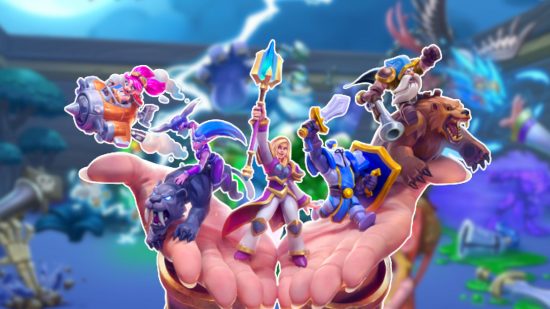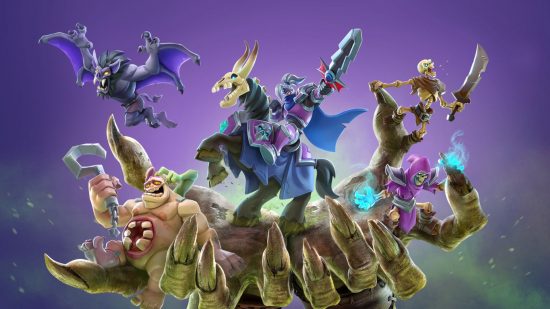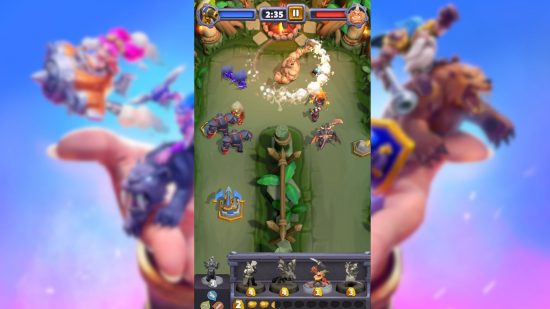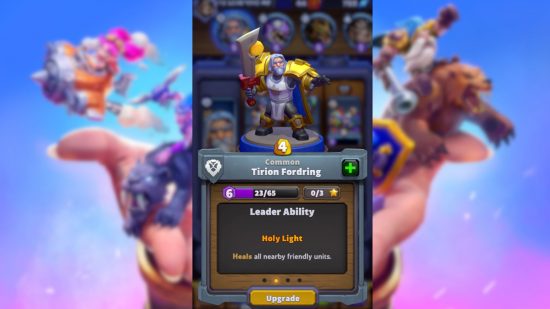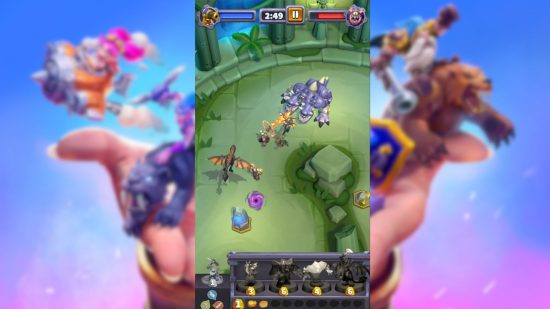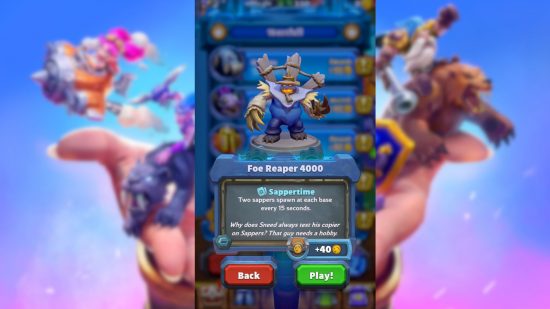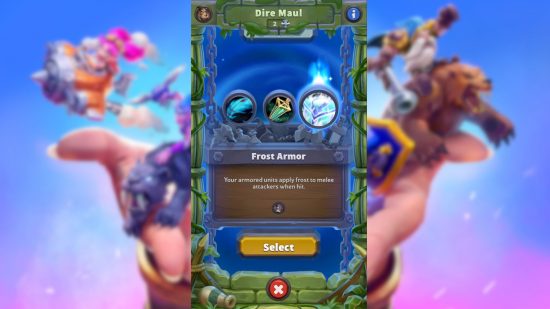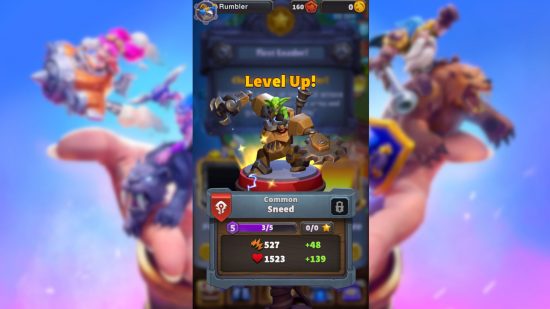With Blizzard first announcing Warcraft Rumble in early 2022, we’ve been patiently waiting for the new mobile title from the much-loved franchise for a while now. But it’s nearly here. After a year of beta testing, a soft launch, and plenty of hype, a new way to engage with characters and factions from the series is on the horizon. So, we thought, what better way to find out more about this action strategy game than to talk to the team responsible?
That’s how I found myself on a Zoom call with Tom Chilton and Vik Saraf, the respective Game Director and Executive Producer of Warcraft Rumble, just over a month in advance of the November 3 release date. As you might expect, there was a palpable excitement on the faces of both developers, eager to express just how excited they are to finally release this game into the wilds of the mobile gaming market.
Naturally, I started at the beginning, asking about how the concept for Warcraft Rumble first emerged from the Blizzard offices. As it’s essentially his baby, Chilton was happy enough to offer a detailed answer.
“It was an idea that slowly developed over a period of years, from when I had a bunch of guildmates in WoW that started playing a game called Puzzle and Dragons a lot. We would go out to guild dinners, and they wouldn’t shut up about it. And so, they finally got me to play it. After giving it a couple of different tries, I started to enjoy it, and that was the game that really kind of opened my eyes to the possibility that you could have [a] deep gameplay experience on mobile. That planted the early seeds in my mind that it could be kind of cool to do a Warcraft game on mobile.”

Puzzle and Dragons wasn’t the only mobile game to influence the early concepts for Warcraft Rumble, though, as Chilton further explained.
“As more mobile games came out, in particular when Clash Royale was released, I thought that was a great example of the adaptation of a lot of the concepts of real-time strategy to mobile. To me, that was a little bit of a lightbulb moment in how the combat system works really well.” It’s interesting that Chilton describes the release of Clash Royale as one of the lightbulb moments, as there are definitely similarities between the two games. However, they’re not two peas from the same pod, and Rumble offers more depth in this strategy element compared to SuperCell’s big hitter RTS.
After playing a little Warcraft Rumble for ourselves, it’s hard to imagine those humble beginnings now. For those that don’t know, this game is a world-within-a-world, with the core concept being that you’re playing on an arcade machine within the world of Warcraft, in the basement of the Hearthstone Taven, to be precise, full of miniature toys representing famous characters from the various Warcraft factions. It’s incredibly detailed, though, offering a cartoonish spin on some of our favorites, including Hogger, Tirion Fordring, and plenty more.
With so many characters to choose from, I asked Chilton and Saraf how they decided on which to include in the early game. After all, that’s the point where you need to grab the player’s attention the most if you want them to hang around for longer than the first few missions. Chilton answered, having obviously spent a lot of time thinking about this himself.
“That was an interesting choice because Warcraft has so much that you can’t possibly use them all, right? You can chip away at a lot of it eventually, but for the initial release, it’s awfully hard to deal with all that. So, one of the things we thought of when we considered that was, well, let’s keep it mostly to the classic time period.” Chilton’s response is essentially what we expected, as it’s something of an industry norm. Just last year, Marvel Snap used classic characters like the Guardians of the Galaxy and Iron Man to introduce the game to audiences, and it fared all the better for it.
Sticking with design for a little longer, I asked the pair about the world design process. World of Warcraft is known for its vast explorable regions, so I wondered how difficult the process might have been to try and distill these epic locations into smaller arenas for RTS battling.
“It was surprising to us how much we had to kind of pare back detail. We started with far more detailed environments, and far more detailed characters, and realized that once we were playing and walking around, things would get lost in the environment. It got hard to pick out one unit from another, it was just too busy.” From our time in the beta, we can tell that a lot of effort has gone into locations. Things can still get a bit hectic on screen, but it’s never too much to tell what is going on, so that’s another mission accomplished for the developer.
“As we visually simplified and figured out what are the most important elements to capture, to communicate the essence of what these characters are and the essence of the environment, that’s when we started to realize that these are almost toy versions of themselves in World of Warcraft. So, we started to orient the creative direction around it being these miniature characters and that it would be in a game machine in the Warcraft universe.”
This whole concept of toy versions of Warcraft characters is one of the most captivating elements of the game, and it’s fascinating to hear how Blizzard found its way there. Considering all the expansions to World of Warcraft and the title’s distinct gameplay, it makes sense not to try and further expand and potentially make decisions that divide the community. This way, Warcraft Rumble can build its own aesthetic and pick and choose from the library of lore Blizzard lords over.
This idea of a game within the universe of Warcraft is particularly interesting to me, so I probed a little more, asking if it gave the development team a creative license to do some things that might not fly in classic WoW.
Chilton says “we wanted to figure out a way to differentiate ourselves. Not only is this a very different game from the standpoint of RTS versus turn-based combat, but also a player interaction in the world standpoint. We were trying to figure out how to create this kind of player versus environment game where you’re playing against the game in addition to having an opportunity to play against players.”
To get the answers they needed, the team asked themselves one simple question – “what was the right thing for that?” Well, as Chilton tells us, “that’s when the idea of this arcade machine, or a pinball machine, just kind of jumped out at us. What if this was like an arcade machine? What if these were little characters that came to life? A lot of people on the team were really into miniatures through Warhammer and stuff like that. So that made total sense, and it resonated in a lot of ways with a lot of us. That was what helped us shape that concept.” Chilton says it makes sense, and I have to agree. There’s something that feels fresh about Warcraft Rumble, which I hadn’t really anticipated considering the series is as old as I am.
Chilton’s earlier comment on how the team had mainly developed for PC before creating Warcraft Rumble led me to my next question. How difficult was it to walk the tight-rope of making an approachable mobile game, while also including enough Warcraft lore to make fans of the series feel at home in a new title?
“A lot of that was expressed in our art style,” explains Chilton. “Our art style decisions were made based on what worked from a gameplay standpoint and a visual read standpoint. We started with much more detailed environments and much more detailed characters that were more directly similar to World of Warcraft itself. But as we found that that just didn’t work, that was when we started to figure out how to adapt that for mobile.”
“If the process of making it have more of a simplified aesthetic ends up having an appeal to a broader demographic, then that’s great. But honestly, that’s not what we were trying to do with that. We were just trying to make sure that the gameplay works as well as possible on the device. Then, as it turns out, the characters are a lot more detailed. We laugh a lot about that. Our characters are far more detailed from a polygons texture standpoint than World of Warcraft characters were in 2004.” This is another honest answer from the developer, though it shines a light on just how far mobile gaming has come, and gaming in general, with this mobile offshoot able to reimagine characters in a higher quality than their original portrayals.
On this question, Saraf adds to Chilton’s point.
“We were a beta for about a year before we went to soft launch.” Having spent the majority of his career working on mobile games, Saraf tells us that “the most important thing that doesn’t distinguish mobile from any other type of platform is the core game loop. We intentionally set out to make sure that we spent enough time to kind of optimizing that because that is largely the most important part of it.”
“Then when we got to a point where we realized our moment-to-moment gameplay and core game loop is at a really good spot.” Times have changed for the mobile game industry as a whole in recent years, something that Saraf understands very well, explaining that “we know that the expectations of mobile gamers for mobile games have increased. It’s no longer a nascent, small industry. It’s a very big, mature market at this point. So, we wanted to make sure that we had a game that also had a lot of depth to coincide with the core game loop.” You can certainly feel how much thought has gone into the gameplay loop while playing, even in the early sections, with levels seamlessly blurring together in short play sessions. There isn’t a shortage of ways to play, though.
On the back of Saraf mentioning the length of time Warcraft Rumble spent in beta, I asked the pair if there had been any ‘eureka’ moments during the late stage of development for Blizzard’s mobile RTS.
“For sure. Some of the things that we weren’t sure about when we first started the project were, you know, what are the things that we’re going to need to do to make sure that the replay of the maps is varied enough?” Chilton tells us. “And then we were also unsure in some cases, like, can we translate some of these bosses into very challenging encounters? So, two very different questions.
“But we ended up kind of really feeling like that for both of those questions, we had those moments. More than anything else, when we sort of devised the Arclight Surge for the replayability of the missions, that’s when we realized that there’s a lot of fertile ground here for creating a different spin on a mission that ends up really kind of giving it an interesting twist and varies the gameplay experience to where it’s fun to play in this different way yet on a map that you kind of know and understand.”
One of the most exciting reveals for Warcraft Rumble was when we learned that raids are going to be a big part of the game. As WoW fans know, raids are one of the things that make the original PC game so popular and cemented its status as a social game, so I asked the pair to tell me a little more about the raid system. Chilton answered this one.
“Raids are, in a lot of ways, the marquee content of World of Warcraft. We wanted to make sure that raids filled that role in our game and to have as much of a conceptual translation of that as possible. So, the things that you can expect in Raid are for the bosses and the maps and all the different things going on all the different mechanics in play, to be a degree more kind of complex than they are in our normal maps.” This answer shows just how dedicated the developers are to making Rumble feel different from WoW while celebrating what makes the series so special. WoW players want to raid, so they can, even if it’s in a different format.
Chilton continued to talk about raids, touching on the debut Molten Core raid. “An example of that would be Lucifer, one of the bosses in the Molten Core raid, who has a bunch of different dominators that are on the map, and they take control of whatever mini approaches them first. So, it’s all about tactics in figuring out ways to get them to dominate something that’s not too concerning for you to take on yourself, while also finding ways to assassinate them.” While I haven’t arrived at raiding myself yet, I can imagine that both these souped-up bosses and co-op elements add another layer to the wider Rumble experience, offering those who buy into the game a way to really test their mettle.
After learning a little about the co-op element in raids, I wanted to learn more about the developer’s expectations and aims for PvP battles. After all, this is a concept that Warcraft Rumble introduces early on and offers an alternative to raiding or PvE battles when you’re looking to take on another player.
Well, Saraf explains that “we wanted to make sure that the PvP experience itself was also something unique that the player could continue to tap into and play over a varied length of time. When you look at the actual details around the PvP, we have six-week seasons, rotating maps that are unique in their own ability, and within each season inside those maps, we have modifiers that change on a bi-weekly basis as well.”
There’s an awareness of Saraf here that a stale meta is a nightmare for both players and developers, promising to keep things fresh with rotating elements for new seasons and during them. We’ve heard these promises before, but it’s apparent that Saraf and the rest of the team take each element of the game seriously and know different ways to play will attract different audiences.
“So whenever the player decides to play PvP, be it a day, a week, or a year from now, they’re getting something that’s a unique experience on its own,” Saraf continues. “And it’s not something redundant, which we know can cause a little bit of boredom. So we’re intentional about wanting to make sure that the PvP experience always feels fresh and improved when you pick it up.”
Before letting Chilton and Saraf get on with the rest of their press rounds, I had to ask if they had a favorite mini from the game. Chilton answered first.
“Having designed most of them, they’re all very dear to me. But easily, one of my favorites is Worgen, because I love assassinating ranged minis behind the line and the tanks.”
Saraf found it similarly difficult to pick a favorite but did offer an answer.
“I love all minis equally. It’s funny because I’m going to be viewed as very inconsistent over the course of many interviews because it changes almost every time. So it’s usually based on where I am today on it. At the minute, I’m leaning towards the Blackrock family more than anything else.”
With that answer, I let Chilton and Saraf continue on their press rounds before I jumped into a bit of Warcraft Rumble myself. What is clear from both our conversation and the gameplay is that there’s a lot of attention to detail in this mobile offshoot, from the high-quality minis to the reimagined locations that marry fantastic mobile design with the aesthetics and lore of World of Warcraft.
So, whether you’re a fan of Warcraft or not, there’s something engaging here. The raid system, in particular, offers something a little different from other action strategy titles on mobile, inspired by some of the content that made World of Warcraft as famous as it is today. Only time will tell if it’s enough to attract an audience of mobile gamers and WoW fans, but as ever, I wouldn’t bet against Blizzard.
For more of us talking to developers, be sure to check out our Zenless Zone Zero interview, PUBG mobile interview, and Mighty Bear Games interview.
